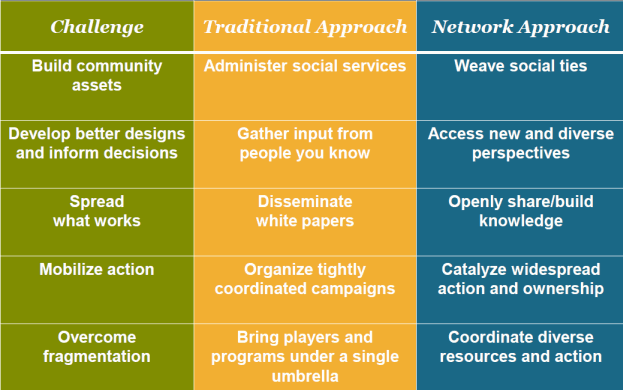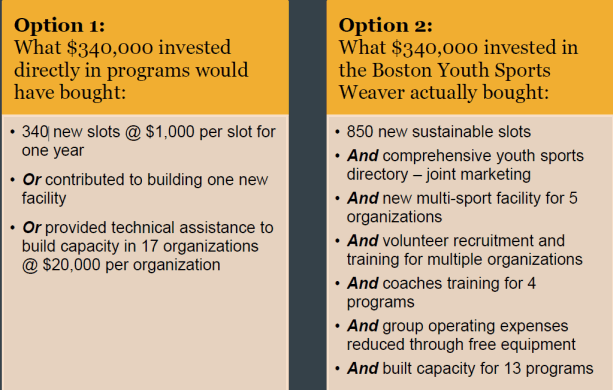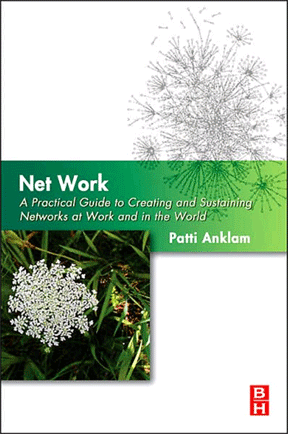Net Work Investment
Since my book came out four years ago, I have been increasingly connecting with groups in the nonprofit sector, consulting with nonprofits, and trying to navigate the differences between enterprises and nonprofits. I have been saying, working from my gut feel, that nonprofits somehow have been sooner to “get it” about networks. There is now emerging a good body of case studies and examples of how intentional, actively supported — and funded — network building within the nonprofit space achieves remarkable results.
A recent webinar sponsored by Grantmakers for Effective Organizations (GEO), “What is the role of Networks in creating scale?” highlighted the work and thinking that is showing results (and is part of the ongoing learning dialogue). The panel for the webinar, included Diana Scearce, of the Monitor Institute (co-author of Working Wikily and more recently, author of the awesome “Connected Citizens: The Power, Peril and Potential of Networks“); Roberto Cremonini of Cremonini Consulting Network (who led knowledge management and networking activities at the Barr Foundation in Boston for seven years); and Gayle Williams, Executive Director of the Mary Reynolds Babcock foundation, which is focused on alleviating poverty in the southern U.S. Nancy Murphy, from GEO, facilitated the panel discussion and kept the remote audience engaged and interacting.
Diana set the stage by providing a framework for network thinking and development, an approach that blends traditional mechanisms for supporting social change initiatives with network-minded mechanisms:
Foundations like the Mary Reynolds Babcock Foundation and the Barr Foundation have been using the networked mindset, and these approaches, effectively, and are working through the challenges of working with multiple stakeholders and learning how to put structures in place that support networked action — and learning — that require giving up on linear thinking and working organically.
Roberto gave a terrific example of how the Barr Foundation managed its funding for Boston youth sports programs by showing, side-by-side, what Barr could accomplish using a traditional approach versus what it could (and did!) accomplish using networked thinking:
Both practitioners emphasized the emergent role of weaver, or facilitator, or “network officer” (as described in the linked document by the Mary Reynolds Babcock Foundation, a good and detailed description of the nitty-gritty of the work required); the need to work with the entire ecosystem; and the importance of understanding accountability. The RE-AMP Energy Network case study provides a good example of building a network by starting with a systemic analysis of the ecosystem and the use of a skilled network facilitator.
A key audience question was, “How do you measure the success of the network?” Gayle Williams talked about the network that MRBF is funding to push tax policy legislation in Alabama. I liked her answer a lot: you can look at the results, actual changes in the tax policy, but also you need to be sure that the network is always asking the questions, “who else needs to be involved?” How are the relationships? How easy is it for people to come into the network?” The speakers all agreed that organizational/social network analysis is playing a key role in helping people “see” their networks and understand how to improve connections.
This excellent webinar is available for replay at: http://www.youtube.com/watch?v=CYudIfermUg
I have always said (and written) that a network produces value based on its purpose, and also provides value to those in it. One of the cases mentioned in this webinar is one I have some personal connections to, the Barr Fellows program which is also supported by the Barr Foundation and facilitated by colleagues at IISC. My friend and colleague Claire Reinelt recently published a case study on this program, which weaves cohorts of nonprofit leaders in the Boston area. Fellows are given 3-month sabbaticals, a shared learning experience somewhere in the global south, and the opportunity to develop “authentic, honest, and accountable relationships with each other.” It’s not hard to imagine the value to the city of Boston of such inter-connectivity across the Fellows, nor the amazing fund of social capital that each of the Fellows has to draw on.
This work, this investment, in networks and communities is one of the areas of commonality between what we are seeing in Enterprise 2.0 and the nonprofit world. In E2.0, the focus is on communities (see my comments on Rachel Happe‘s talk at the E2.0 conference — and her talk itself, The Strategic Imperative of Communities) but I refuse to get into the semantic arguments about the differences between networks and communities. For the purposes of declaring that work gets gone, goals get accomplished, and visions achieved best through connected sets of people, it doesn’t matter. Nor does it matter what we call them when there are opportunities to learn. The big learning so far this week: E2.0 and nonprofits agree. If you want to work successfully, you have to invest in networks. Community managers/facilitators/network officers/network weavers. Whatever you call them, you need them, and you need to invest in them.



 #E2conf
#E2conf
 I really like the image of the collaborative platform as a coral reef, a rich ecosystem of people and ideas both using and building on the platform, contributing while they interact. Big schools of small fish, small schools of big fish, eels, crabs, and skates; rainbow fish and clowns; shy tetra and angels and sergeants finding their way, their food, their friends among the diversity of coral. And, like the
I really like the image of the collaborative platform as a coral reef, a rich ecosystem of people and ideas both using and building on the platform, contributing while they interact. Big schools of small fish, small schools of big fish, eels, crabs, and skates; rainbow fish and clowns; shy tetra and angels and sergeants finding their way, their food, their friends among the diversity of coral. And, like the  I heard a great talk this morning by
I heard a great talk this morning by 
